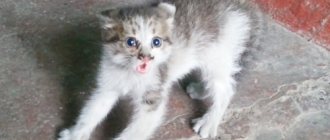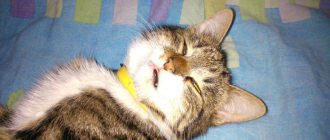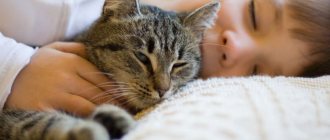Some people have the opinion that cats do not need to be taught to be handled, since they themselves are ready to sit on their owners’ laps for hours. But it is not always the case. Many owners dream of having this purring miracle sitting in their arms, because they so want to stroke and cuddle the kitten, and everyone knows that our pets are a good antidepressant.
They, with their characteristic arrogance, allow themselves to be fed, cared for, but as for their hands... Moreover, this applies not only to an adult taken home, but also to a cat raised with their own hands, groomed from a tiny kitten. In our article we will try to explain in detail what causes this cat behavior and how to accustom a cat to handling.
Reasons why a cat doesn't like to be held
Animal psychologists say that there are some good reasons why cats do not like to sit in their owner's arms. Let's look at some of them:
- Firstly, it is difficult to sit a kitten in your arms that has lived on the street for a long time. If no one has ever held him in their arms before, he will sincerely not understand why he needs to sit on his master’s lap. Well, they fed me, gave me something to drink, but why these incomprehensible hugs?
- The cat does not like to be without balance, in weightlessness, this is exactly how the pet perceives this situation when it is at the height of human height.
- There are cats that are afraid of heights.
- Bad memories do not allow the kitten to relax and calmly sit on its owner’s lap. If the animal is a street animal or from a family where it was not treated particularly well, or, on the contrary, was abused, then it will be difficult for it to adapt to a new relationship. The cat's memory has a completely different picture of what can be expected from human hands.
- The pungent odor emanating from the owner may not allow the cat to sit in his arms. As you know, cats have a highly developed sense of smell; their delicate nose perceives even the most insignificant odors. Those odors that come from the owner's hands can be pungent and extremely unpleasant for him. It could be the smell of washing powder, detergent, hand cream, or your favorite French perfume.
- There are also some especially freedom-loving breeds that do not tolerate “calf” tenderness, an abundance of communication and the master’s hands. They prefer solitude. These cats are good for busy business people who are rarely at home. These are breeds such as the British, Scottish Fold.
Closed and shy cats
Some cats not only avoid being held, but are generally not inclined to actively communicate with humans.
They do not like to be touched, avoid stroking and try to escape whenever their owners try to pick them up. If the cat is healthy, and such behavior is habitual for it, then, most likely, its dislike of physical contact was formed in childhood. A kitten that was not held or petted at an early age is unlikely to begin to experience a craving for sitting in a person's arms as it gets older. In the best case, the animal can lie nearby, maintaining some distance. If a cat was born and raised on the street, then it is hardly surprising that human touches make her wary.
An animal's negative life experiences cause it to experience fear, associating the proximity of human hands with unpleasant events and sensations. Only the sensitivity and patience of her owner will help her overcome this fear and learn to trust people again, at least her own.
How not to behave around a cat
Cats are quite freedom-loving and touchy creatures. If the owner has ever offended the cat, the cat will never approach him again. And you can’t even dream of him jumping onto your lap. If the cat receives affection and attention from the owner, then gradually he will get used to the person and respond with mutual affection.
It should be remembered that cats will never do anything against their will. There is no need to forcefully hold them on your knees; this still will not lead to the desired result. The animal itself must want to sit or sleep on its owner’s lap.
If a small kitten tolerates the owner’s caresses normally, then at the first sign of anxiety, it should be released. When the animal begins to nervously beat its tail on the floor, it says that I’m tired, I have a lot of things to do.
What to do
Love and care will help you win your cat's favor
First of all, we need to talk about what not to do. You cannot force a cat to be affectionate and purr in the hands of a person. Any coercion will only make the situation worse.
If the cat is sick, then after healing it may again become affectionate and sociable. Although some diseases greatly change the animal’s psyche.
A frightened pet can be returned to a healthy state only with tact, affection and care. But a cat that not only walks, but also lives on its own, cannot be tamed (literally). You need to come to terms with the fact that such an independent creature lives next to you.
Respect the individuality of each animal. This will help establish a harmonious relationship with your pet. And harmony lies in the fact that everyone who lives next to you should feel good.
Some training methods
If you are not one of those lucky people whose cats love to sit or even sleep in your arms, and you really want your pet to be “tame,” then you need to know that there are different ways to help tame this wild miracle:
- All cats love to eat tasty food, and it is better for a well-fed, dozing kitten to allow itself to be taken on your lap.
- An affectionate monotonous conversation with a pet encourages mutual communication. He, listening to the owner’s gentle speeches, will begin to squint and squint. In this state of mind, the pet will jump into the owner's arms.
- Animal psychology claims that a cat should get used to being handled gradually, in several stages. First you just need to pet her behind the ear, all cats adore this. Once the pet is near your palms, you do not need to grab it and hold it by force.
- You can act with the help of treats. At first, you can feed the kitten by hand, then put the yummy food on your lap. He will certainly jump after her. At the stage when your pet, having jumped up for a tasty treat, is in no hurry to jump back, but calmly eats it, you can try stroking it with your other hand. You shouldn’t hold him back by jumping on your lap over and over again; he will get used to it; giving him a treat will help instill in his master’s hands how to receive pleasure.
- If your cat is afraid of heights and weightlessness, then look at how correctly you are holding it and whether it is experiencing a feeling of pain. When lifting a kitten, you cannot hold it by the withers or by the body near the ribs. You need to hold the armpits of the front paws with one hand, and place the other under the hind paws. This way he won't feel like he's floating in the air.
- If the kitten is terribly afraid of heights, then first you can pick him up while sitting on your knees.
- Often the rapprochement between the owner and the cat occurs during play. At first, you can play with a bow or wrapper on the floor, gradually bringing the toy closer to your lap. As soon as the pet is in your arms, you need to let go of the toy and leave it under the full control of the animal. While he is enjoying the caught prey, he himself, without realizing it, is in his arms and at an unconscious level there is a period of adaptation.
- Some owners carry very small kittens in the pockets of terry dressing gowns; they sit there like kangaroos and get used to the owner’s smell. In the meantime, he will perceive the robe as his property, and the owner's smell will always be associated with the sweet period of childhood.
- As a last resort, pet stores have cat sprays with a high content of pheromones, which attract pets like a magnet. If you spray your palms with this miraculous method, the cat itself will reach out to you. You should not use this product often, because, against the background of pheromones, it will become addictive and then another problem will arise: how to wean your pet off cat spray. Catnip can be substituted for cat spray.
You need to understand that a kitten gets used to its owner’s hands faster than an adult cat; in the latter case, more patience will be required.
Knowing the free-thinking and independent nature of a cat, you can get along with your pet without much difficulty. If you still cannot achieve the desired result, then you need to leave it alone. After all, cats are quite characteristic animals, and character, as we know, changes throughout life.
How to accustom your pet to its place?
Buying a house or bedding for a cat is half the battle. It can be much more difficult to accustom a kitten or an adult animal to it. First of all, care should be taken that the personal space of a mustachioed friend meets such criteria as stable construction, comfort, convenience, and free access. In this case, the animal will get used to it much easier.
It happens that a cat, having quickly examined a new house, immediately chooses it as its main place. However, this does not always happen, and to tame a pet you must resort to ingenuity. Among the basic techniques:
- accustoming to a new corner;
- the location of the house where the mustachioed friend likes to relax;
- soft coercion.
Features of training a kitten
It is important to ensure that the pet's bed is ready on the first day of its stay in the new home. It should be convenient for the animal to enter it and rest comfortably
During the cold season, additional heating may be needed. The baby will explore the territory for a long time, and it is important to observe his actions. If he likes a certain corner for relaxation, you should move the bed to it.
Lodge training can be achieved through a daily ritual. You should play with the kitten near the bedding and put his favorite toys there. A child who is playing up will not miss the opportunity to visit again where he was interested and comfortable. Having noticed that the animal is resting in the house, it is worth praising it and rewarding it with a treat. At first, you can place a bed or a house next to the chair where the owner is resting. When the kitten gets used to being on its bed, you should move its bed to the pet’s permanent sleeping place.
Techniques for “persuading” an adult animal
How to accustom an adult cat to a new house after it has been settled or moved? Conservative animals often ignore the bed, preferring to live on their favorite upholstered furniture or window sill. First of all, you need to guess with the placement of the new place. Sometimes it is enough to move the bed to where the pet likes to be. For example, on the sofa. The cat will like to sleep on a softer bedding, and if there are toys in it, he will not want to leave. After the mustachioed friend gets used to the bed, it can be placed in the corner where the owner needs it.
You can get used to the house in the same way, placing it near the places where the animal likes to be. You can encourage your pet to visit with toys, treats, kind words and praise. If you can’t influence an adult cat, you can buy “Catnip” spray (or valerian infusion) at a pet store and treat the animal’s bed. The smell will attract your pet, and he will be able to appreciate the comfort of his place. You need to use the product for several days. You can do without scents by laying a bedding or blanket in the house, which the mustache loves.
Appearance of British and Scottish kittens
British and Scottish Fold kittens differences:
| Characteristics | British cats | Scottish cats |
| Body | They have a stocky and slightly squat body | More graceful features predominate. The body has relatively small dimensions |
| Head | Massive round head with a large jaw and pronounced cheekbones | The head is smaller, shaped like an owl's |
| Tail | Thick and muscular | Flexible and long |
| Ears | Straight, erect, rounded ears | Two types of ears: Scottish Strike (straight) and Scottish Fold (dropping) |
| Paws | Short, massive limbs | Slender paws with correctly selected proportions in relation to the body |
| Wool | Plush short fur | Fluffier with rich undercoat |
| Eyes | Oval oblong eye shape. Eye color is the most varied, orange shades dominate | Wide open round eyes. Color matches coat color |
Now you know that the Scottish fold cat and the British cat have differences in appearance and they are obvious. However, this is not all the individual characteristics of the two breeds.
The Scots and the British have different personalities, which is also important to consider when choosing a kitten to purchase.
Which breed and in what case is it better to choose?
It is better for a child to get a kitten than to introduce him to an adult cat.
For families with children, it is better to choose Scottish cats - kittens will get along well with children who already understand that a cat is a living creature and not a toy. "Scottish women" are completely devoid of sudden attacks of aggression. The British cat is suitable for busy people who respect the animal’s personal space. She will not behave aggressively with the child, but from an excess of attention to her person she will hasten to leave.
Video: the difference between Scottish and British cats
https://www.youtube.com/embed/Ra6sKc7Z9kw https://www.youtube.com/embed/ekiFbTEGalc
The Scottish cat breed is more suitable for families with children. In turn, the British one will fit perfectly into the life of a busy person who spends more time at work rather than at home.
Features of training pedigree cats
Purebred cats are taken from friends, pet stores, nurseries and shelters. They teach rules of behavior consistently and patiently.
Hemorrhoids in cats, cats and kittens: how to treat
First, the cat is given a nickname, short and sonorous. They repeat it often and kindly. When he responds and approaches, he is rewarded with a treat. They constantly talk to the ward. Cats understand not words, but intonation. They react sensitively to the mood of the owner and understand the mood by tone.
At the same time, they are taught to behave correctly. One command is a ban, then, when the cat understands and begins to comply, another useful habit. The kitten is given an understanding of what it should not do: bite its owner, scratch furniture. Forbidden "Ugh!" and “You can’t!”, accompanied by the clapping of palms, the pupils understand quickly.
Important! The animal is rewarded for following commands, and punished for misdeeds. But immediately, and not in a few hours, the cat will not understand and will harbor a grudge
Beatings are unacceptable.
Pets are taught not to climb on the table. They are taught to eat in one place and from the same utensils, to go to the toilet using a tray or toilet. Poking a kitten's nose into its puddle is inhumane and pointless. It is better to patiently lead him to the right place, stay with him, and encourage him after the right actions.
Toys for pets are important in the process of getting used to a new place
Veterinary service
A foundling is always dangerous. Ectoparasites can live on his skin: fleas, ticks, lice. The internal “residents” – helminths – are called endoparasites. Wherever there is a concentration of wild animals, viruses and insects are infested.
The homeless child is first bathed, the skin is treated with drops, sprays, and shampoos. Anti-worm tablets are given internally. Next, the veterinarian prescribes a comprehensive vaccination. The animal must be free from helminths, so vaccinations are done after quarantine and tests for the presence of worms. They are vaccinated against rabies, lichen, and calcivirus infection.
Taming a kitten, whether stray or from a breeder, is not difficult. Fluffy pets always live with people, so they easily get used to new living conditions. Patience, love and affection will turn an animal into a pet who will bring joy to the house.











